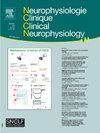疼痛性多发性神经病患者与持续神经性疼痛相关的脑功能连通性变化
IF 2.4
4区 医学
Q2 CLINICAL NEUROLOGY
Neurophysiologie Clinique/Clinical Neurophysiology
Pub Date : 2025-09-01
DOI:10.1016/j.neucli.2025.103102
引用次数: 0
摘要
目的探讨周围多发性神经病疼痛性的脑功能连通性变化。方法对26例疼痛性或无痛性多发性神经病患者进行静息状态功能磁共振成像(rs-fMRI)检查。根据先前发表的结果,研究人员研究了默认模式网络(DMN)、丘脑内和丘脑皮质连接,以及参与慢性疼痛体验的“伤害性”、“注意力”和“情绪”方面的不同大脑网络(疼痛矩阵)的连通性。结果各组间DMN连通性无明显变化。疼痛性多神经病变患者的丘脑皮质连通性降低,特别是与运动皮层相连的丘脑簇,而无痛性多神经病变患者的丘脑内(中外侧)连通性增加。在疼痛性多发性神经病变患者中,疼痛基质内的连通性增加,尤其是“伤害性”基质,而在无痛性多发性神经病变患者中,“注意力”和“情绪”疼痛基质之间的连通性增加。脑岛后叶和顶盖间的连接增加与神经性疼痛症状评分和疼痛对日常功能的影响呈正相关。结论疼痛性多神经病变的特征是每个疼痛基质内连通性增加,某些丘脑簇的丘脑皮质连通性降低,特别是与运动皮质相关。相反,无痛性多神经病变的特征是丘脑内和不同疼痛基质之间的连通性增加。尽管必须承认各种方法的局限性(样本量小,缺乏健康受试者的对照组或在神经影像学检查期间测量疼痛强度),但这些结果提供了与疼痛性多神经病变相关的脑连接变化的新信息。这项研究也为解释运动皮质刺激治疗慢性神经性疼痛的疗效提供了新的论据。本文章由计算机程序翻译,如有差异,请以英文原文为准。
Changes in brain functional connectivity associated with ongoing neuropathic pain in patients with painful polyneuropathies
Objective
To assess changes in brain functional connectivity associated with the painful nature of peripheral polyneuropathy.
Methods
Resting-state functional magnetic resonance imaging (rs-fMRI) was performed in 26 patients with painful or painless polyneuropathy. According to previously published results, connectivity was studied regarding the default mode network (DMN), intrathalamic and thalamocortical connections, and, the different brain networks (pain matrices) involved in the "nociceptive", "attentional" and "emotional" aspects of the chronic pain experience.
Results
No change in DMN connectivity was found between groups. Thalamocortical connectivity was reduced in patients with painful polyneuropathy, especially for the thalamic cluster connected to the motor cortex, while intra-thalamic (mediolateral) connectivity was increased in patients with painless polyneuropathy. Intra-connectivity was increased within the pain matrices, especially the "nociceptive" matrix, in patients with painful polyneuropathy, while inter-connectivity was increased between the "attentional" and "emotional" pain matrices in patients with painless polyneuropathy. Increased connectivity between the posterior insula and parietal operculum positively correlated with the neuropathic pain symptom score and impact of pain on daily functioning.
Conclusions
Painful polyneuropathy was characterized by increased intra-connectivity within each pain matrix and reduced thalamocortical connectivity of certain thalamic clusters, notably linked to the motor cortex. Conversely, painless polyneuropathy was characterized by increased connectivity within the thalamus and between the different pain matrices. Although various methodological limitations must be acknowledged (small sample size, lack of a control group of healthy subjects or measurement of pain intensity during neuroimaging examination), these results provide new information on the changes in brain connectivity associated with painful polyneuropathies. This study also brings new arguments to explain the efficacy of motor cortex stimulation in the treatment of chronic neuropathic pain.
求助全文
通过发布文献求助,成功后即可免费获取论文全文。
去求助
来源期刊
CiteScore
5.20
自引率
3.30%
发文量
55
审稿时长
60 days
期刊介绍:
Neurophysiologie Clinique / Clinical Neurophysiology (NCCN) is the official organ of the French Society of Clinical Neurophysiology (SNCLF). This journal is published 6 times a year, and is aimed at an international readership, with articles written in English. These can take the form of original research papers, comprehensive review articles, viewpoints, short communications, technical notes, editorials or letters to the Editor. The theme is the neurophysiological investigation of central or peripheral nervous system or muscle in healthy humans or patients. The journal focuses on key areas of clinical neurophysiology: electro- or magneto-encephalography, evoked potentials of all modalities, electroneuromyography, sleep, pain, posture, balance, motor control, autonomic nervous system, cognition, invasive and non-invasive neuromodulation, signal processing, bio-engineering, functional imaging.

 求助内容:
求助内容: 应助结果提醒方式:
应助结果提醒方式:


